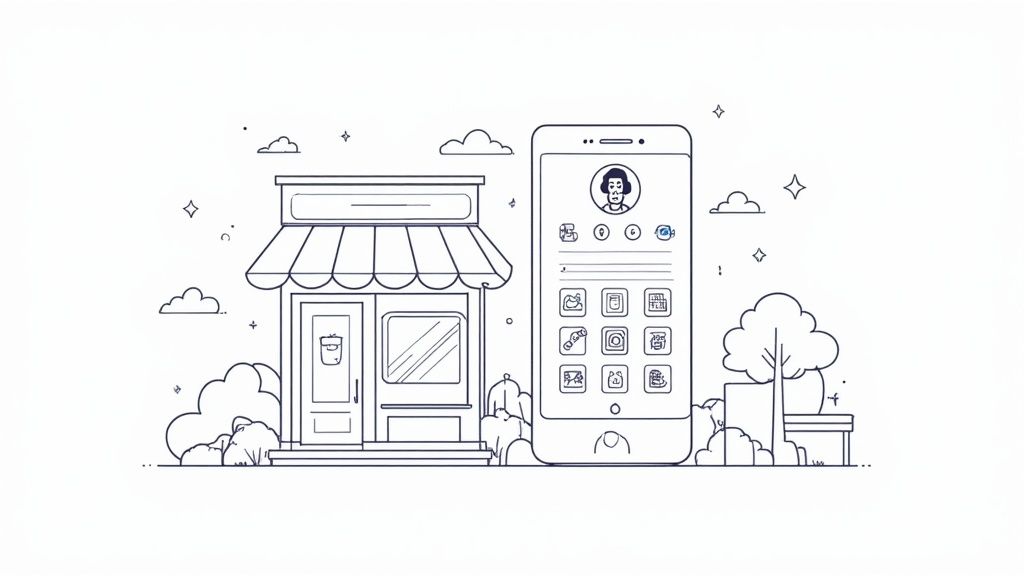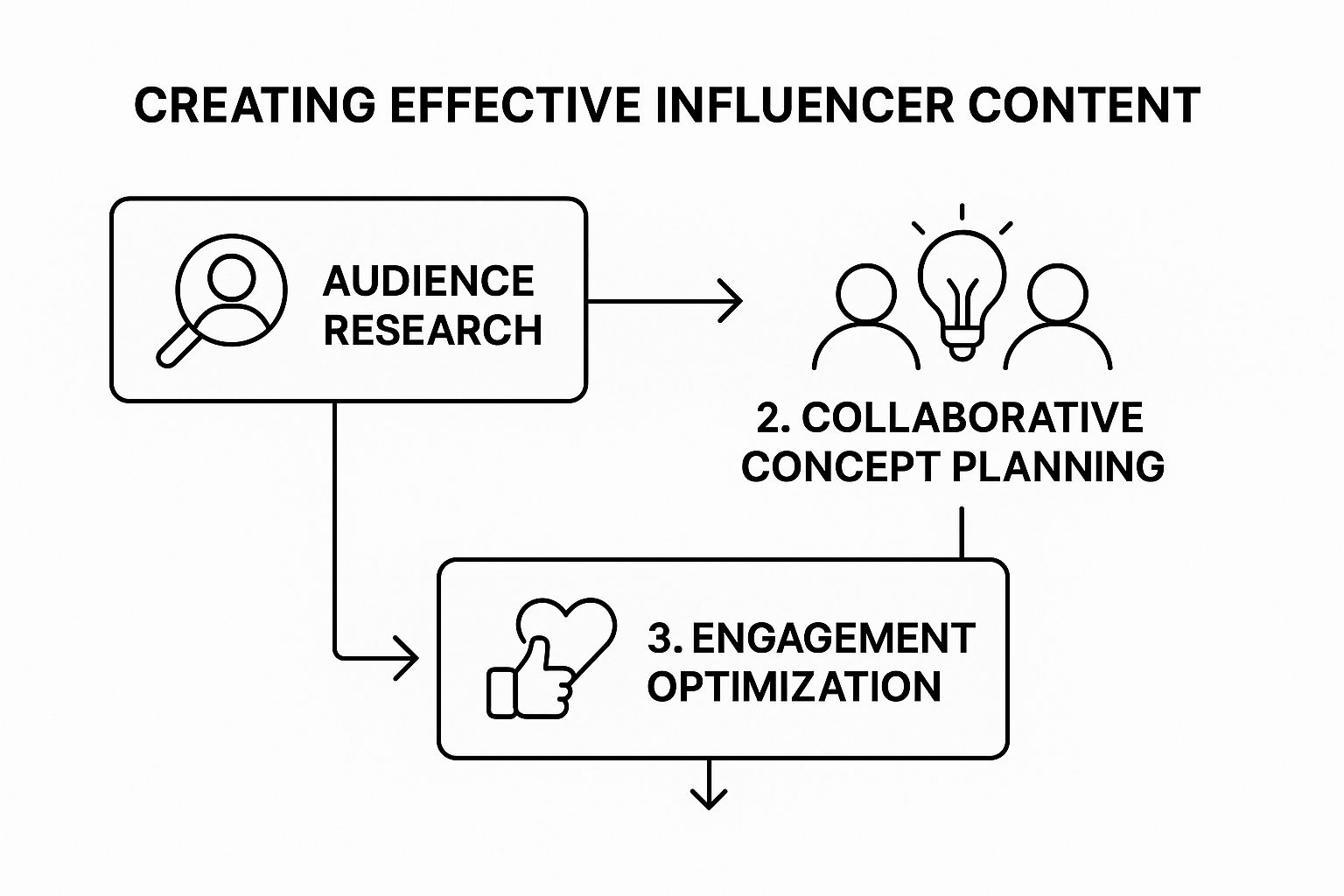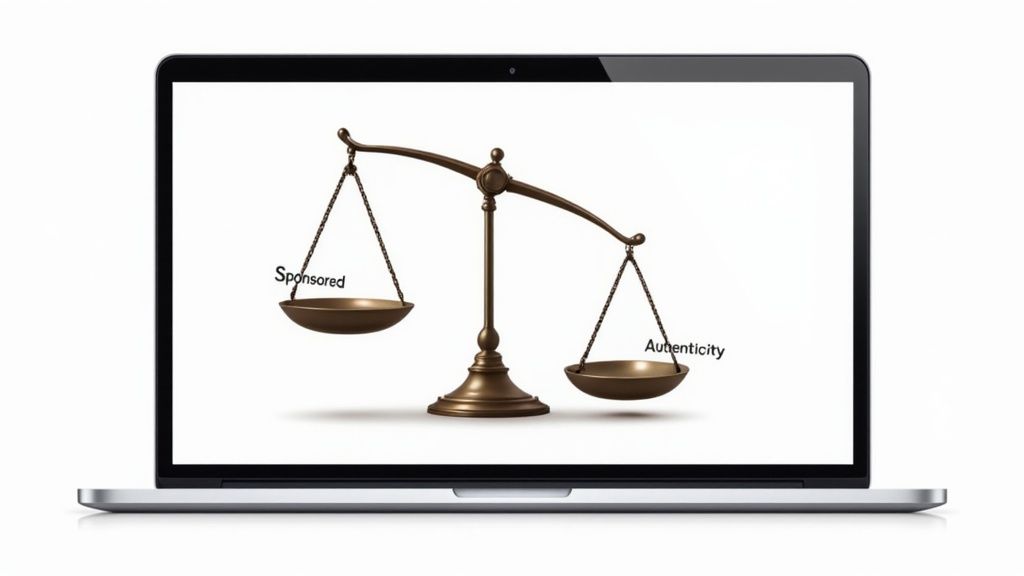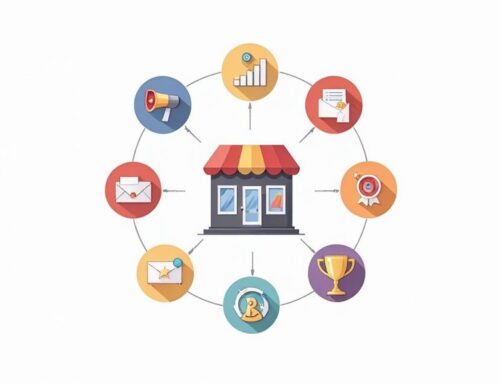Gone are the days when influencer marketing was a playground reserved for giant corporations with bottomless budgets. For a small business, it’s one of the most powerful ways to build real trust and connect with niche audiences that traditional ads just can’t reach. It’s less about massive spending and more about smart, strategic partnerships that can give you a serious leg up on the competition.
Why Influencer Marketing Is a Small Business Powerhouse

I’ve seen many small business owners write off influencer marketing, thinking it’s too expensive or complex. The truth is, it’s one of the best ways to slice through the constant digital noise and connect with people on a human level.
Think about it. When a creator your ideal customer already follows and admires recommends your product, it doesn’t feel like a pushy ad. It feels like a genuine tip from a friend. This is where the magic happens.
This strategy is all about authenticity. Imagine a local artisan bakery teaming up with a neighborhood food blogger. That blogger’s honest excitement over a new sourdough loaf can drive more real foot traffic than a generic newspaper ad ever could, simply because their followers trust their palate. Or picture an online boutique that sells sustainable fashion partnering with a micro-influencer who champions eco-friendly living. The connection is natural and powerful.
Building Real Trust and Credibility
The heart of influencer marketing for small business is its power to build credibility. People are tired of slick, corporate ads; they’re practically immune to them. An influencer partnership, on the other hand, offers third-party validation that feels authentic and earned. For a growing brand, that kind of trust is priceless.
This trust translates directly into better engagement and, you guessed it, more sales. You’re no longer just shouting your message into the digital abyss. Instead, you’re joining a conversation already happening within a community that’s genuinely interested in what you offer. This is a core piece of a much larger puzzle, which you can dive into with our complete guide on digital marketing for small business.
Key Takeaway: Influencer campaigns sidestep the usual ad-blocking mentality. You’re tapping into established, trusting communities, which helps build long-term customer relationships and drives tangible results, from generating leads to making direct sales.
To help you decide if this is the right move for your business, here’s a quick breakdown of how influencer marketing stacks up against more traditional advertising methods.
Influencer Marketing vs Traditional Ads for Small Businesses
| Factor | Influencer Marketing | Traditional Advertising |
|---|---|---|
| Trust Factor | High (Leverages existing trust) | Low (Often viewed with skepticism) |
| Targeting | Hyper-specific (Niche communities) | Broad (Demographic-based) |
| Cost | Flexible (From free products to fees) | High upfront costs (Media buys) |
| Engagement | High (Interactive and conversational) | Low (Typically one-way communication) |
| ROI Tracking | Highly measurable (Promo codes, links) | Difficult to track direct ROI |
| Content | Authentic, user-generated feel | Polished and professionally produced |
As you can see, for a small business focused on building a loyal customer base and making every dollar count, influencer marketing often has a clear advantage.
A Cost-Effective Engine for Growth
Maybe the most compelling reason for small businesses to jump in is the incredible return on investment. Unlike expensive TV spots or print ads with fuzzy results, influencer collaborations offer clear, trackable outcomes.
The numbers don’t lie. It’s projected that in 2025, small businesses will see an average return of $5.78 for every $1 spent on influencer marketing. This kind of ROI is driven by the authentic bond influencers have with their followers—a bond that builds a level of trust and conversion power other channels can only dream of.
By focusing on micro or nano-influencers who have smaller but fiercely loyal followings, you can launch incredibly effective campaigns without a massive budget. It’s all about being smarter and more targeted with your marketing spend, turning genuine relationships into your most valuable asset.
Finding the Right Influencers on a Budget

Here’s the good news: you don’t need a huge budget to find fantastic brand champions. For a small business, the secret isn’t chasing celebrities. It’s about finding creators with smaller, but fiercely loyal, followings. This is where micro and nano-influencers come in.
Their communities are often incredibly tight-knit. When they recommend a product, it doesn’t feel like a stuffy ad—it feels like a genuine tip from a trusted friend. That’s the kind of authentic connection that actually drives sales for a growing brand.
You might be surprised at how many of these creators are out there. In fact, on Instagram alone, nano-influencers (those with the smallest, most niche followings) made up a massive 75.9% of the creator base in 2024. That’s a huge pool of potential partners waiting for the right brand. If you want to dive deeper into the numbers, the full influencer marketing benchmark report is a great resource.
Smart Search Techniques on Social Platforms
Your hunt for the perfect influencer should start exactly where your customers are—on social media. Forget about just looking for big follower counts. Your goal is to find genuine passion and a perfect fit for your brand.
A great place to begin is with niche hashtags. Let’s say you sell handmade ceramic mugs. Instead of a broad search, try digging into tags like #potterylove, #handmademugs, or #coffeemoments. This will quickly show you who’s already creating content and having conversations in your specific world.
Don’t forget to look in your own backyard, too. Who’s already tagging your brand or showing off your products? These existing fans are gold. They’re your warmest leads for a collaboration because their love for what you do is already real.
Vetting Potential Partners Like a Pro
Once you have a shortlist of promising creators, it’s time to do some homework. Follower count alone can be deceiving, so you need to look for real engagement and authenticity. This is a critical step, much like the targeted strategies we cover in our guide to small business lead generation.
Here’s what I look for when vetting a potential partner:
- Go Beyond Likes: Are people leaving thoughtful comments? Are they asking the creator questions? A healthy comment section is a much better sign of an active community than a high like count.
- Check Their Past Sponsored Posts: How do they integrate paid partnerships? You want someone whose sponsored content feels natural and fits seamlessly with their other posts. If their feed looks like a billboard of random ads, it’s a red flag.
- Verify Follower Quality: Take a quick scroll through their followers. Do they look like real people with genuine profiles, or do you spot a lot of spammy, bot-like accounts? Sudden, unnatural spikes in their follower growth can also be a warning sign.
A creator with 3,000 highly engaged followers in your niche is infinitely more valuable than one with 50,000 passive followers who couldn’t care less about what you sell.
By shifting your focus to these smaller, more authentic creators, you can build incredibly effective partnerships that drive real business results—all without breaking the bank. It’s all about finding the right fit, not just the biggest name.
Crafting Outreach That Builds Real Partnerships
Let’s be honest: generic, copy-paste DMs are the fastest way to get your brand ignored. Influencers, especially the good ones, are bombarded with these messages daily. If you want to build a real partnership—not just a one-off transaction—your first message needs to prove you’ve actually done your homework.
So, how do you stand out? Start by showing you’re a genuine fan. Don’t just say, “I like your feed.” That’s lazy. Instead, get specific. Try something like, “I absolutely loved your recent post on finding the best local coffee shops. The way you captured the morning light was stunning and really aligns with our brand’s focus on authentic daily moments.” See the difference? One is a generic compliment; the other proves you’re paying attention.
This isn’t just about flattery. It’s about laying the foundation for a genuine relationship, which is the heart of successful influencer marketing for small business. You’re starting a collaboration, not just buying ad space.
Structuring a Win-Win Compensation Offer
Once you’ve made that initial connection, the conversation will naturally shift to compensation. As a small business, I know budgets can be tight. But don’t let that stop you. You have more flexibility than you think, and there are several ways to create a deal that works for everyone.
Here are a few models I’ve seen work incredibly well:
- Product Seeding: This is a fantastic, low-risk starting point, particularly with nano-influencers who are building their portfolio. You send them free products in exchange for honest feedback and, hopefully, a post. It’s a great way to test the waters and see if they genuinely love what you do.
- Affiliate Commissions: This is a pure performance-based play. You give the influencer a unique discount code or a trackable link, and they earn a percentage of every sale they drive. It directly ties their efforts to your bottom line, making it a clear win-win.
- Flat Fees: When you have specific deliverables in mind (like one Reel and three Stories), a flat fee is the industry standard. Rates are all over the map, but don’t get hung up on follower count alone. Focus on the value and engagement they bring. A rough starting point for micro-influencers can be around $250-$450 per 10,000 followers, but remember, everything is negotiable.
A true partnership should feel like a win for both sides. Be upfront about what you can afford, but also be ready to get creative. Sometimes the best deals involve a mix, like a smaller flat fee combined with a generous product package.
Finalizing the Agreement
No matter how friendly and casual your conversations have been, always get the terms down in writing. This isn’t about being overly formal or mistrustful; it’s about protecting both you and the influencer by making sure there are no surprises later. A simple, clear agreement is all you need.
Make sure your agreement clearly covers these key points:
- Clear Deliverables: Be specific. Don’t say “a post.” Say “One Instagram Reel (60-90 seconds) featuring the product and two Instagram Stories with a swipe-up link.”
- Content Usage Rights: This is a big one. How can you use the content they create? Can you put their photos on your website? Repurpose them for email marketing or social ads? Spell it out.
- Key Timelines: Lock in the dates. Include deadlines for when you’ll receive a draft, provide feedback, and when the final content should go live.
- Payment Terms: Detail the agreed-upon compensation and the payment schedule. A common structure is 50% upfront to kick things off and 50% once the final content is live.
Putting everything in writing sets a professional tone from the start. It turns a simple outreach message into the beginning of a successful, long-lasting partnership.
Running Your First Influencer Campaign
Alright, you’ve found the perfect influencer and they’re on board. Now for the exciting part—moving from planning to doing. This is where your campaign actually comes to life. The goal here is to manage all the moving pieces so the launch is smooth and feels like a true partnership, not a one-sided transaction.
The secret to a great campaign? A clear, yet flexible, brief. This document is your North Star. It guides the creator without being a suffocating script. After all, the best influencer marketing for small business works because the creator’s authentic voice connects with their audience. Your brief should act as a set of guardrails, empowering them to make content their followers will genuinely respond to.
Building an Effective Campaign Brief
A solid campaign brief is the bedrock of your collaboration. It gets everyone on the same page about goals and messaging right from the start, which helps you sidestep any frustrating miscommunications later on. Think of it as your shared playbook.
And don’t worry, this doesn’t need to be some 20-page legal document. Clarity and brevity are your friends. Here’s what I always recommend including:
- Campaign Goals: What’s the main objective? Is it getting your brand name out there, driving people to your website, or making sales? Be specific.
- Key Talking Points: If the audience only remembers 1-3 things about your product, what should they be? Keep this part focused and simple.
- Mandatory Elements: This is where you list the non-negotiables. Think required hashtags like
#ador#yourbrandpartner, the social media handles to tag (@yourbrand), or a specific call-to-action like, “Use my code BIZ15 for 15% off!” - Content Do’s and Don’ts: Offer some gentle direction here. For example, “Do show the product being used in a real-life setting,” but “Don’t just show it sitting against a plain white background.”
The visual below maps out the typical journey of creating influencer content that really hits the mark, from the initial discovery phase all the way to optimization.

As you can see, this process is built on collaboration. It’s the key to making sure the final content feels authentic to the creator while still being perfectly on-brand for your business.
Managing Logistics and Going Live
Once the creator gives your brief the thumbs-up, it’s all about logistics. I find a simple, shared calendar or a basic timeline is a lifesaver for tracking key dates. Map out when you expect content drafts, when you’ll provide your feedback, and the final go-live schedule. A little coordination upfront prevents a ton of last-minute stress.
When the campaign is live, your work isn’t quite done. You need to be actively monitoring the posts. Jump into the comments section! Answer questions, thank people for their kind words, and just be present. It shows you’re an engaged member of the community, not just a brand paying for a shout-out.
Expert Tip: Don’t let fantastic influencer content vanish into the social media ether after 24 hours. A huge part of a smart strategy is repurposing. Make sure your agreement gives you permission to use the influencer’s high-quality photos and videos on your own marketing channels.
You can feature their content on your product pages, sprinkle it into your email newsletters, or even use it in your own social media ads. This stretches the lifespan of the campaign and squeezes maximum value out of every penny you spent. It’s a powerful way to add social proof across all your marketing and turn a single post into a long-term asset for your brand.
Measuring What Matters and Proving Your ROI

So, the content is live and the initial buzz starts to fade. Now comes the most important question of all: did it actually work?
Answering that question means looking past the easy-to-see vanity metrics. Sure, a mountain of likes and a jump in followers feels great, but those numbers don’t directly pay the bills. The real mark of success in influencer marketing for small business is proving a tangible return on your investment (ROI).
You need to focus on the key performance indicators (KPIs) that connect directly to your business’s bottom line. It’s about shifting your focus from fuzzy engagement to hard data. This is what separates a one-off campaign from a repeatable, scalable growth strategy.
Tracking With Purpose
The smartest way to measure success is to build the tracking right into your campaign from the get-go. This doesn’t have to be complicated, but it does require some forethought. By giving each influencer their own unique tracking tools, you can see exactly who is driving results.
Here are a few of the most effective methods I’ve used:
- Custom UTM Links: Think of these as your secret weapon for tracking web traffic. By creating a unique URL with UTM parameters for each influencer, you can log into Google Analytics and see exactly how many people clicked through to your site from their specific post or story. No more guesswork.
- Unique Discount Codes: This is one of the cleanest ways to track direct sales. Assign a special, memorable code (like “CHLOE20”) to each creator. Every time a customer uses that code at checkout, you know precisely who sent them your way.
- Dedicated Landing Pages: For bigger partnerships, you might build a simple, unique landing page just for that influencer. All their traffic gets sent to that one page, making it incredibly easy to isolate and analyze their impact.
Don’t just celebrate the sale—analyze the path to purchase. Knowing which influencer’s audience converts best is a powerful piece of intel that will shape all your future partnership decisions. This is what being data-driven is all about.
Analyzing Your Campaign Results
Once the campaign has run its course, it’s time to pull all your data together and see what story it tells. You don’t need a fancy report; a simple spreadsheet is often enough. Your goal is to understand what worked, what didn’t, and most importantly, why. Digging into these results helps you calculate your specific influencer marketing ROI with much greater confidence.
The numbers back this up. The global influencer marketing industry is exploding, projected to reach $32.55 billion by 2025. This growth is powered by a relentless focus on tangible results. In fact, brands running Instagram influencer campaigns see an average ROI of $4.12 for every dollar spent.
When you measure correctly, influencer marketing stops being a hopeful experiment and becomes a predictable, profitable part of your business plan. It gives you the confidence that your marketing dollars are genuinely working for you.
Your Top Influencer Marketing Questions, Answered
Jumping into influencer marketing for the first time? You probably have a lot of questions. That’s completely normal. As a small business owner, you need straight answers to feel confident about where you’re putting your time and money.
Let’s clear up some of the most common uncertainties we see. This isn’t about theory; it’s about practical advice to help you get your first campaign off the ground without a hitch.
How Much Should I Pay a Micro-Influencer?
This is always the first question, and the real answer is, “it depends.” I know that’s not what you want to hear, but there isn’t a one-size-fits-all price tag. The final number really comes down to a few things: their audience size, how engaged those followers are, and what exactly you’re asking them to create.
For micro-influencers (think 10,000 to 100,000 followers), you have some great, budget-friendly options.
- Product Gifting: This is often a perfect starting point, especially for smaller campaigns or with creators who are genuine fans of your brand already. It’s often called “product seeding.”
- Flat Fees: When you need specific deliverables, like one Instagram Reel and two Stories, a flat fee makes sense. This can be anything from $100 to over $500 per post. The trick is to negotiate based on the value they’re bringing, not just their follower count.
The best way to start this conversation? Simply ask for their media kit or rate card. It’s professional, respectful, and sets the stage for a good negotiation.
Do I Really Need a Formal Contract?
Yes. 100% yes. Even if it’s a simple one-page agreement and you’ve built a fantastic, friendly relationship, you need a contract. Think of it as a tool for clarity, not mistrust. It’s there to protect both of you.
A solid agreement simply prevents headaches and “I thought you meant…” moments later on.
Your agreement doesn’t need to be full of complicated legal jargon. A clear, straightforward document that covers the essentials is all you need to keep the partnership professional and smooth.
Make sure it clearly spells out the scope of work (e.g., “one permanent in-feed Instagram post and three promotional Stories”), content usage rights (this is a big one!), payment details, and deadlines.
What’s the Biggest Mistake Small Businesses Make?
Easy. The single biggest mistake is picking an influencer based purely on follower count. A massive audience means absolutely nothing if those people aren’t your target customers or if they don’t actually interact with the content. It’s the classic quantity-over-quality trap.
Instead, your focus should always be on relevance and engagement rate. An influencer with 5,000 highly-engaged followers in your city who are obsessed with your niche is infinitely more valuable than one with 50,000 passive followers from all over the world.
For a small business, this targeted approach is everything. Find the people who will be true champions for your brand, not just the ones with the biggest numbers.
Ready to build authentic connections and drive real growth for your brand? The experts at ReachLabs.ai specialize in creating data-driven influencer marketing strategies that deliver measurable results. Learn how our team can connect you with the right creators to elevate your brand. Find out more at ReachLabs.ai.





